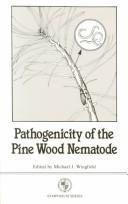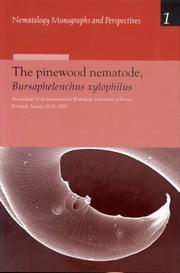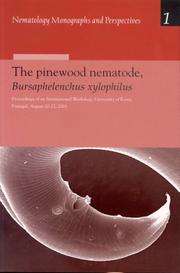| Listing 1 - 10 of 11 | << page >> |
Sort by
|
Book
ISBN: 0241895006 Year: 1976 Publisher: London Hamilton
Abstract | Keywords | Export | Availability | Bookmark
 Loading...
Loading...Choose an application
- Reference Manager
- EndNote
- RefWorks (Direct export to RefWorks)
Book
ISBN: 1527573931 Year: 2021 Publisher: Newcastle upon Tyne, England : Cambridge Scholars Publishing,
Abstract | Keywords | Export | Availability | Bookmark
 Loading...
Loading...Choose an application
- Reference Manager
- EndNote
- RefWorks (Direct export to RefWorks)
After devastating vast ranges of pine forests in Asian countries, Pine Wilt disease invaded European forests, becoming a worldwide threat. Originating in North America, the pathogen of this forest epidemic is a nematode, a long filamentous organism, only 1mm in length. Nematodes are carried from tree to tree by a long-horned beetle, where they lurk in its trachea and thereby spread the disease. The challenges raised for researchers to develop effective control methods were to discover how such tiny nematodes infect and kill large pine trees within a short period, and how the infection spreads repeatedly each year. Other key issues include how giant pine trees die within a short period of time due to infection by these small nematodes, how various organisms involved in this disease correlate to each other, how host trees differently respond to nematode invasion among pine species, and how environmental factors affect the progression and spread of the disease.This book is a record of the fantastic and ingenious research by many tenacious researchers who have worked to clarify these issues. Information on a wide range of fields, from molecular biology to microbiology, nematology, entomology, botany, and ecology, has been incorporated into pine wilt research. Therefore, this book will greatly stimulate the curiosity and research motivation of those interested in field biology and the conservation of the natural environment.
Pinewood nematode. --- Conifer wilt. --- Plant pathology & diseases.

ISBN: 113814987X 1136723722 1315024209 113672365X 9781136723728 0415942047 9780415942041 9781315024202 9781136723797 9781138149878 Year: 2002 Publisher: New York London
Abstract | Keywords | Export | Availability | Bookmark
 Loading...
Loading...Choose an application
- Reference Manager
- EndNote
- RefWorks (Direct export to RefWorks)
First Published in 2002. Routledge is an imprint of Taylor & Francis, an informa company.
Blues musicians --- White, Josh. --- Pinewood Tom --- Singing Christian --- White, Joshua,

ISBN: 0890540837 Year: 1987 Publisher: St. Paul (Minn.) : APS press,
Abstract | Keywords | Export | Availability | Bookmark
 Loading...
Loading...Choose an application
- Reference Manager
- EndNote
- RefWorks (Direct export to RefWorks)
Conifer wilt. --- Pine --- Pinewood nematode. --- Diseases and pests.

Abstract | Keywords | Export | Availability | Bookmark
 Loading...
Loading...Choose an application
- Reference Manager
- EndNote
- RefWorks (Direct export to RefWorks)
Conifer wilt --- Pine --- Pinewood nematode --- Diseases and pests

ISBN: 9789047413097 9789004132672 Year: 2004 Publisher: Leiden; Boston : BRILL
Abstract | Keywords | Export | Availability | Bookmark
 Loading...
Loading...Choose an application
- Reference Manager
- EndNote
- RefWorks (Direct export to RefWorks)
According to the European Plant Protection Organization, the pinewood nematode (PWN), Bursaphelenchus xylophilus is a quarantine organism at the top of the list of the pathogenic species. PWN may be found in North America (Canada, USA and Mexico) and in East Asia (Japan, Korea, China and Taiwan) and has a highly destructive capability towards conifers, in a relatively short time, causing serious economic damage in Japan, China and Korea. This nematode surveying is extremely important and a correct identification of nematode species associated with conifers is essential. Several conifers species are very susceptible (Pinus sylvestris, Pinus nigra and Pinus pinaster), the last one (maritime pine) is a particulary important economic specie in Portugal, and in southern Europe. In 1999, this nematode was found and identified for the first time in Portugal and in Europe. During 1999 and 2000, the Portuguese government, following an alert provided to European Community officials initiated an extensive national survey. During 2000 and 2001, research has been carried out regarding the morphobiometric as well as molecular (DNA: ITS-RFLP) characterization of the collected populations, as well as closely related species of Bursaphelenchus. The book details the Proceedings of an international workshop held at the University of Évora in 2001, covering all major aspects of the bioecology of the pinewood nematode (PWN), Bursaphelenchus xylophilus, its insect vectors and effects on the tree. Topics covered are: global issues and national surveys; morphology and molecular methods of identification of PWN; ecology and epidemiology; quarantine issues; tree physiology, resistance and histopathology; biology of PWN and relationships to its cerambycid vectors; control methods. General quarantine and political views are also presented.
Conifer wilt --- Pine --- Pinewood nematode --- Diseases and pests
Book
ISBN: 0520969898 9780520969896 9780520297593 9780520297609 0520297598 0520297601 Year: 2020 Publisher: Berkeley, California : University of California Press,
Abstract | Keywords | Export | Availability | Bookmark
 Loading...
Loading...Choose an application
- Reference Manager
- EndNote
- RefWorks (Direct export to RefWorks)
Studios are, at once, material environments and symbolic forms, sites of artistic creation and physical labor, and nodes in networks of resource circulation. They are architectural places that generate virtual spaces—worlds built to build worlds. Yet, despite being icons of corporate identity, studios have faded into the background of critical discourse and into the margins of film and media history. In response, In the Studio demonstrates that when we foreground these worlds, we gain new insights into moving-image culture and the dynamics that quietly mark the worlds on our screens. Spanning the twentieth century and moving globally, this unique collection tells new stories about studio icons—Pinewood, Cinecittà, Churubusco, and CBS—as well as about the experimental workplaces of filmmakers and artists from Aleksandr Medvedkin to Charles and Ray Eames and Hollis Frampton.
Motion picture studios --- History --- aleksandr medvedkin. --- architecture. --- art studio. --- artists space. --- arts production. --- brazil. --- cbs. --- charles eames. --- churubusco. --- cinecitt. --- cinema. --- creativity. --- digital arts lab. --- eames brothers. --- film history. --- film production. --- film studio. --- film. --- filmmaking. --- glass studio. --- hollis frampton. --- illumination. --- industry. --- light. --- lucasfilm. --- media history. --- media studies. --- media technologies. --- mosfilm. --- nikkatsu mukojima. --- pinewood. --- production studio. --- ray eames. --- space theory. --- studio space. --- studio system. --- technology.
Book
ISBN: 1281757179 9786611757175 1402084552 1402084544 904817886X Year: 2008 Publisher: Dordrecht : Springer,
Abstract | Keywords | Export | Availability | Bookmark
 Loading...
Loading...Choose an application
- Reference Manager
- EndNote
- RefWorks (Direct export to RefWorks)
The pinewood nematode (PWN), Bursaphelenchus xylophilus, the causal agent of pine wilt disease (PWD), is a serious pest and pathogen of forest tree species, in particular among the genus Pinus. It was first reported from Japan in the beginning of the XXth century, where it became the major ecological catastrophe of pine forests, with losses reaching over 2 million m3/ year in the 1980s. It has since then spread to other Asian countries such as China, Taiwan and Korea, causing serious losses and economic damage. In 1999, the PWN was first detected in the European Union (EU), in Portugal, and immmediately prompted several government (national and EU) actions to assess the extent of the nematode’s presence, and to contain B. xylophilus and its insect vector (Monochamus galloprovincialis) to an area with a 30km radius in the Setúbal Peninsula, 20 km south of Lisbon. International wood trade, with its political as well as economic ramifications, has been seriously jeopardized. The origin of the population of PWN found in Portugal remains elusive. Several hypotheses may be considered regarding pathway analysis, basically from two general origins: North America or the Far East (Japan or China). World trade of wood products such as timber, wooden crates, palettes, etc… play an important role in the potential dissemination of the pinewood nematode. In fact, human activities involving the movement of wood products may be considered the single most important factor in spreading of the PWN. Despite the dedicated and concerted actions of government agencies, this disease continues to spread. Very recently (2006), in Portugal, forestry and phytosanitary authorities (DGRF and DGPC) have announced a new strategy for the control and ultimately the erradication of the nematode, under the coordination of the national program for the control of the pinewood nematode (PROLUNP). Research regarding the bioecology of the nematode and insect as well as new detection methods, e.g., involving real-time PCR, has progressed since 1999. International agreements (GATT, WTO) and sharing of scientific information is of paramount importance to effectively control the nematode and its vector, and thus protect our forest ecosystems and forest economy.
Pinewood nematode. --- Pinewood nematode --- Conifer wilt. --- Pine --- Control. --- Diseases and pests --- Aphelenchoides lignophilus --- Aphelenchoides xylophilus --- Bursaphelenchus lignicolus --- Bursaphelenchus lignophilus --- Bursaphelenchus xylophilus --- Laimaphelenchus lignophilus --- Pine wood nematode --- Bursaphelenchus --- Pine wilt disease --- Wilt disease of pine --- Wilt of conifers --- Conifers --- Nematode diseases of plants --- Wilt diseases --- Pines --- Pinus --- Pinaceae --- Forests and forestry. --- Plant diseases. --- Invertebrates. --- Plant Ecology. --- Forestry. --- Plant Pathology. --- Botany --- Plants --- Ecology --- Invertebrata --- Animals --- Communicable diseases in plants --- Crop diseases --- Crops --- Diseases of plants --- Microbial diseases in plants --- Pathological botany --- Pathology, Vegetable --- Phytopathology --- Plant pathology --- Vegetable pathology --- Agricultural pests --- Crop losses --- Diseased plants --- Phytopathogenic microorganisms --- Plant pathologists --- Plant quarantine --- Forest land --- Forest lands --- Forest planting --- Forest production --- Forest sciences --- Forestation --- Forested lands --- Forestland --- Forestlands --- Forestry --- Forestry industry --- Forestry sciences --- Land, Forest --- Lands, Forest --- Silviculture --- Sylviculture --- Woodlands --- Woods (Forests) --- Agriculture --- Natural resources --- Afforestation --- Arboriculture --- Logging --- Timber --- Tree crops --- Trees --- Pathology --- Diseases --- Wounds and injuries --- Phytoecology --- Vegetation ecology --- Plant pathology. --- Plant ecology. --- Floristic ecology
Book
Year: 2021 Publisher: Basel, Switzerland MDPI - Multidisciplinary Digital Publishing Institute
Abstract | Keywords | Export | Availability | Bookmark
 Loading...
Loading...Choose an application
- Reference Manager
- EndNote
- RefWorks (Direct export to RefWorks)
Renewable fuels and chemicals derived from lignocellulosic biomass offer unprecedented opportunities for replacing fossil fuel derivatives, reducing our overdependence on imported oil, and mitigating current climate change trends. Despite technical developments and considerable efforts, breakthrough technologies are still required to overcome hurdles in developing sustainable biorefineries. In recent years, new biorefinery concepts including a lignin-first approach and a closed-loop biorefinery have been introduced to tackle technoeconomic challenges. Furthermore, researchers have advanced the development of new technologies which enable the utilization of biomass components for sustainable materials. It is now apparent that advanced processes are essential for ensuring the success of future biorefineries. This book presents processes for biomass fractionation, lignin valorization, and sugar conversion or introduces new bioproducts (chemicals and materials) from renewable resources, addressing the current status, technical/technoeconomic challenges, and new strategies.
Technology: general issues --- Biomass --- two-step pretreatment --- steam explosion --- organosolv treatment --- empty fruit bunch --- pinewood --- green pretreatment --- enzymatic hydrolysis --- lignin structural features --- poplar --- FTIR --- contaminants --- by-products --- lignin valorization --- lignin applications --- 3D printing --- electrochemical material --- medical application --- drying effect --- cellulose --- hornification --- porosity --- bioethanol --- economic analysis --- hand sanitiser --- oil palm empty fruit bunch (OPEFB) --- simultaneous saccharification and fermentation --- SuperPro Designer® --- renewable fuel --- high-density fuel --- α-pinene dimerization --- turpentine --- stannic chloride molten salt hydrates --- xylooligosaccharides --- autohydrolysis --- sweet sorghum bagasse --- isobutanol --- biorefinery --- metabolic engineering --- biomass utilization --- aqueous biphasic system --- dilute acid hydrolysate --- furfural production --- solvent extraction --- response surface methodology --- biomass fractionation --- bioproducts
Book
Year: 2021 Publisher: Basel, Switzerland MDPI - Multidisciplinary Digital Publishing Institute
Abstract | Keywords | Export | Availability | Bookmark
 Loading...
Loading...Choose an application
- Reference Manager
- EndNote
- RefWorks (Direct export to RefWorks)
Renewable fuels and chemicals derived from lignocellulosic biomass offer unprecedented opportunities for replacing fossil fuel derivatives, reducing our overdependence on imported oil, and mitigating current climate change trends. Despite technical developments and considerable efforts, breakthrough technologies are still required to overcome hurdles in developing sustainable biorefineries. In recent years, new biorefinery concepts including a lignin-first approach and a closed-loop biorefinery have been introduced to tackle technoeconomic challenges. Furthermore, researchers have advanced the development of new technologies which enable the utilization of biomass components for sustainable materials. It is now apparent that advanced processes are essential for ensuring the success of future biorefineries. This book presents processes for biomass fractionation, lignin valorization, and sugar conversion or introduces new bioproducts (chemicals and materials) from renewable resources, addressing the current status, technical/technoeconomic challenges, and new strategies.
Biomass --- two-step pretreatment --- steam explosion --- organosolv treatment --- empty fruit bunch --- pinewood --- green pretreatment --- enzymatic hydrolysis --- lignin structural features --- poplar --- FTIR --- contaminants --- by-products --- lignin valorization --- lignin applications --- 3D printing --- electrochemical material --- medical application --- drying effect --- cellulose --- hornification --- porosity --- bioethanol --- economic analysis --- hand sanitiser --- oil palm empty fruit bunch (OPEFB) --- simultaneous saccharification and fermentation --- SuperPro Designer® --- renewable fuel --- high-density fuel --- α-pinene dimerization --- turpentine --- stannic chloride molten salt hydrates --- xylooligosaccharides --- autohydrolysis --- sweet sorghum bagasse --- isobutanol --- biorefinery --- metabolic engineering --- biomass utilization --- aqueous biphasic system --- dilute acid hydrolysate --- furfural production --- solvent extraction --- response surface methodology --- biomass fractionation --- bioproducts
| Listing 1 - 10 of 11 | << page >> |
Sort by
|

 Search
Search Feedback
Feedback About UniCat
About UniCat  Help
Help News
News